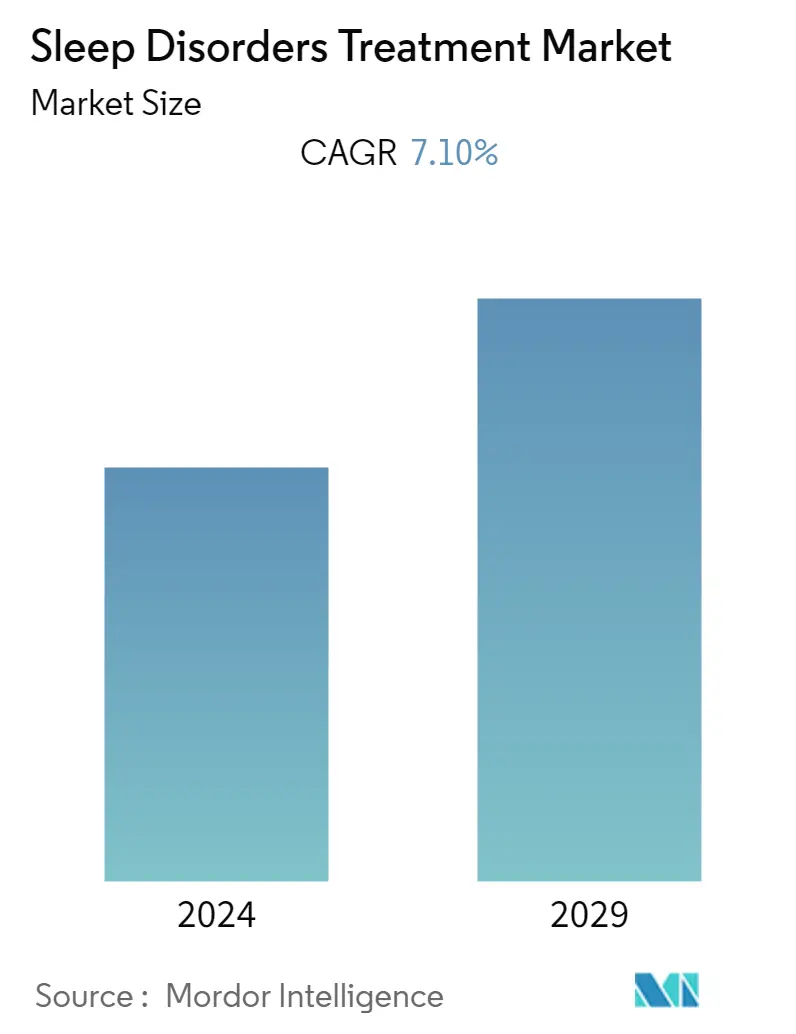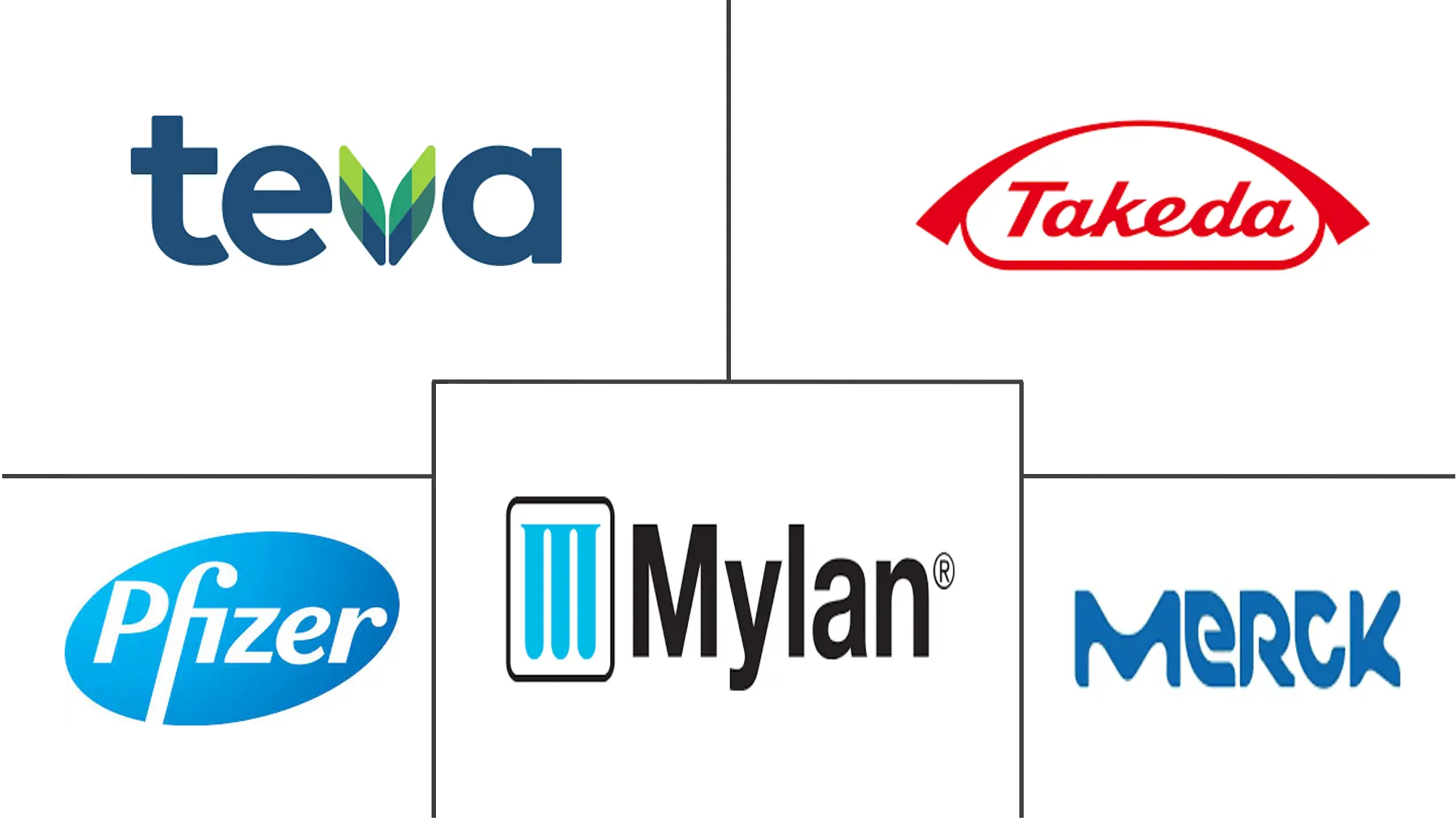Market Size of Sleep Disorders Treatment Industry

| Study Period | 2021 - 2029 |
| Base Year For Estimation | 2023 |
| Forecast Data Period | 2024 - 2029 |
| CAGR | 7.10 % |
| Fastest Growing Market | Asia Pacific |
| Largest Market | North America |
Major Players
*Disclaimer: Major Players sorted in no particular order |
Sleep Disorder Treatment Market Analysis
The sleep disorders treatment market is anticipated to witness a CAGR of nearly 7.1% during the forecast period.
COVID-19 had a significant impact on the growth of the market. According to the NCBI article published in March 2022, in Europe, the incidence of new-onset COVID-19-related insomnia was as high as 13.6%, whereas the prevalence of clinical insomnia was 18.6% in 2021. According to another study published in September 2020 in Springer, the patients with obstructive sleep apnea experienced around eight times greater risk for COVID-19 infection compared to a similar-aged population receiving care in a major racially and socio-economically diverse healthcare system. Obstructive sleep apnea was linked to an increased risk of hospitalization in COVID-19 infection patients, as well as a nearly doubled risk of developing respiratory failure. Thus, the COVID-19 infections had a significant impact on the growth of the market. The increasing adoption of sleep disorder treatment is expected to drive the growth of the market over the coming five years.
The major factors driving the market include the increasing incidences of sleep apnea, an increase in the geriatric population, an increase in the prevalence of obesity and hypertension, and increasing awareness among the patient population in developing countries. Aging is a major factor driving the market growth for sleep apnea devices as the elderly are the most at risk for developing this disorder.
The increasing prevalence of sleep disorders and the increasing awareness among people about sleep disorders across the world are contributing to the market's growth. As per the Helsestart data on global insomnia statistics in 2022 and 2023, half of US adults experience insomnia once a month or more. Around 59% of adults in the West suffer from insomnia at some point or another, making it the most susceptible region in the world. The same source also stated that people in Japan, Taiwan, and Sweden have the biggest struggle with insomnia, more than any other country worldwide. Norway has the most searches for melatonin in the world, i.e., a massive 520 times per 100,000 people from 2021 to 2022, 67 more times than Sweden.
An increase in awareness about sleep disease among the general population is expected to propel the sleep disorders treatment market. The rising number of people suffering from a host of sleep disorders, including hallucinations, sleep paralysis, disrupted nocturnal sleep, insomnia, sleep apnea, narcolepsy, and circadian disorders, caught the attention of governments across the world, forcing them to take necessary steps to address this condition.
The approval and commercialization of new drugs by market players are also expected to play a crucial role in driving the market in the coming years. For instance, in January 2022, Idorsia received FDA approval for the drug Quviviq for the treatment of insomnia, which may improve sleep with less grogginess. Similarly, in August 2021, Jazz Pharmaceuticals received US FDA approval for its drug Xywav for the treatment of patients with idiopathic hypersomnia, a rare neurologic disorder that can result in daytime sleepiness despite having a prolonged night of sleep.
However, lower diagnosis rates and side effects of sleep disorders drugs may hamper the market's growth.
Sleep Disorder Treatment Industry Segmentation
As per the scope of the report, sleep disorders such as insomnia, restless legs syndrome, and narcolepsy can affect certain aspects of the patient's life and lead to the development of chronic diseases.
The sleep disorders treatment market is segmented by drug type (benzodiazepines, nonbenzodiazepines, antidepressants, and other drug types), application (insomnia, sleep apnea, narcolepsy, circadian disorders, and other applications), and geography (North America, Europe, Asia-Pacific, Middle East and Africa, and South America). The market report also covers the estimated market sizes and trends for 17 different countries across major regions globally. The report offers the value (in USD million) for the above segments.
| By Drug Type | |
| Benzodiazepines | |
| Nonbenzodiazepines | |
| Antidepressants | |
| Orexin Antagonists | |
| Melatonin Antagonists | |
| Other Drug Types |
| By Application | |
| Insomnia | |
| Sleep Apnea | |
| Narcolepsy | |
| Circadian Disorders | |
| Other Applications |
| By Geography | ||||||||
| ||||||||
| ||||||||
| ||||||||
| ||||||||
|
Sleep Disorders Treatment Market Size Summary
The sleep disorder treatment market is poised for significant growth, driven by a combination of increasing awareness and the rising prevalence of sleep disorders globally. Factors such as the growing geriatric population, obesity, and hypertension are contributing to the market's expansion. The COVID-19 pandemic has further exacerbated sleep issues, with a notable rise in insomnia and sleep apnea cases, which in turn has spurred demand for effective treatment solutions. The market is characterized by the introduction of new drugs and therapies, with regulatory approvals playing a crucial role in enhancing treatment options. Despite challenges like lower diagnosis rates and potential side effects of medications, the market is expected to thrive, particularly with the ongoing development of innovative treatments.
North America is anticipated to maintain its dominance in the sleep disorder treatment market, supported by high healthcare expenditure, favorable reimbursement policies, and a strong clinical pipeline. The region's market growth is also fueled by increasing stress levels and a heightened awareness of sleep disorders and their treatments. The market landscape is moderately fragmented, with numerous manufacturers offering generics and a few key players focusing on branded drugs. Companies are actively investing in research and development to create new chemical entities and novel molecules, aiming to capture a larger market share. This competitive environment, coupled with strategic initiatives like direct-to-consumer campaigns and integrated healthcare centers, is expected to drive the market's growth in the coming years.
Sleep Disorders Treatment Market Size - Table of Contents
-
1. MARKET DYNAMICS
-
1.1 Market Overview
-
1.2 Market Drivers
-
1.2.1 Increasing Awareness Related to Target Disorders Among the Patient Population
-
1.2.2 Rising Stress Levels and Changing Dynamics
-
1.2.3 Presence of Potential Clinical Pipeline Candidates
-
-
1.3 Market Restraints
-
1.3.1 Lower Diagnosis Rate
-
1.3.2 Side Effects of Sleep Disorder Drugs
-
-
1.4 Porter's Five Forces Analysis
-
1.4.1 Threat of New Entrants
-
1.4.2 Bargaining Power of Buyers/Consumers
-
1.4.3 Bargaining Power of Suppliers
-
1.4.4 Threat of Substitute Products
-
1.4.5 Intensity of Competitive Rivalry
-
-
-
2. MARKET SEGMENTATION (Market Size by Value - USD million)
-
2.1 By Drug Type
-
2.1.1 Benzodiazepines
-
2.1.2 Nonbenzodiazepines
-
2.1.3 Antidepressants
-
2.1.4 Orexin Antagonists
-
2.1.5 Melatonin Antagonists
-
2.1.6 Other Drug Types
-
-
2.2 By Application
-
2.2.1 Insomnia
-
2.2.2 Sleep Apnea
-
2.2.3 Narcolepsy
-
2.2.4 Circadian Disorders
-
2.2.5 Other Applications
-
-
2.3 By Geography
-
2.3.1 North America
-
2.3.1.1 United States
-
2.3.1.2 Canada
-
2.3.1.3 Mexico
-
-
2.3.2 Europe
-
2.3.2.1 Germany
-
2.3.2.2 United Kingdom
-
2.3.2.3 France
-
2.3.2.4 Italy
-
2.3.2.5 Spain
-
2.3.2.6 Rest of Europe
-
-
2.3.3 Asia-Pacific
-
2.3.3.1 China
-
2.3.3.2 Japan
-
2.3.3.3 India
-
2.3.3.4 Australia
-
2.3.3.5 South Korea
-
2.3.3.6 Rest of Asia-Pacific
-
-
2.3.4 Middle East and Africa
-
2.3.4.1 GCC
-
2.3.4.2 South Africa
-
2.3.4.3 Rest of Middle East and Africa
-
-
2.3.5 South America
-
2.3.5.1 Brazil
-
2.3.5.2 Argentina
-
2.3.5.3 Rest of South America
-
-
-
Sleep Disorders Treatment Market Size FAQs
What is the current Sleep Disorders Treatment Market size?
The Sleep Disorders Treatment Market is projected to register a CAGR of 7.10% during the forecast period (2024-2029)
Who are the key players in Sleep Disorders Treatment Market?
Merck & Co, Mylan N.V., Pfizer, Takeda Pharmaceutical Company Limited and Teva Pharmaceutical Industries Ltd. are the major companies operating in the Sleep Disorders Treatment Market.

